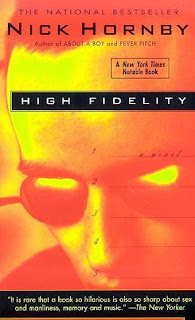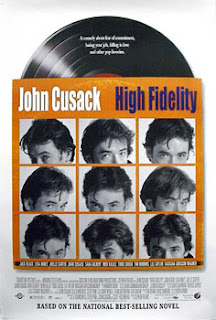It was a rite of passage,
it was a confirmation of devotion,
it was the deepest expression of one's affection,
it was the music of the last romantic:
The Mix Tape.

The compilations that I would obsess over,
late into the night, and early into the morning,
my bedroom-slash-recording studio slowly exploding
in a jumbled mess of hundreds of CDs, tapes, and records,
smoking cigarette after cigarette,
taking shots of affordable Tanduay Rhum
or pilfering my dad's stash of premium Black Label and Smirnoff,
feeling every note, hyper-analyzing the song sequence,
mentally doing the arithmetic for the 45-minute sides,
making sure that my tapes were cued just right:
just the right amount of silence between the tracks
to ensure that the lyrics and sentiment would sink in
before the next one took the wooing to the next level.
No wonder that high among my
TOP 5 Books and Films ever,
are both iterations of HIGH FIDELITY;
The story,
both on the page and on the screen, is pretty simple:
how tongue-tied boys would prefer/need
to express their "tsope" feelings through music,
and the magic of the mix tape.
Author Nick Hornby's spot-on dialogue on the page,
exquisitely delivered by John Cusack in the film,
make High Fidelity the true classic
of "dick lit" and the "dick flick",
essential for every young man to survive
the minefields of love.

"Now, the making of a good compilation tape is a very subtle art.
Many do's and don'ts.
First of all,
you 're using someone else's poetry to express how you feel.
This is a delicate thing."
THE TOP 5 ESSENTIALS OF THE PERFECT MIX TAPE:
Rule #1. The Perfect Song Selection> In the jurassic days, pre-MP3, pre-Kazaa, pre-Lime/Frostwire,
it was actually very difficult to source all the songs that I wanted
to put on my tapes; I remember that I had to buy expensive CDs
or raid my friends' music collections all over Manila, and
from Pampanga to Bicol, just to get the perfect songs.
> That was what really made the tapes special;
the sheer determination and effort involved to assemble
all the songs was definitely a big part of the charm
and convincing magic mojo of the mix tape.
"It takes ages longer than it might seem.
You gotta kick it off with a killer to grab attention.
Then you gotta take it up a notch.
But you don't want to blow your wad.
So then you gotta cool it off a notch.
There are a lot of rules."
Rule #2. The Sound Quality of the Tape> There were three kinds of cassette tapes,
Normal, Chrome, and Metal:
Normal tapes were very cheap, and the sound was muffled;
Chrome was quite expensive, but the recordings sounded like CDs;
Metal was hard to find, prohibitive and actually quite, well, heavy.
> I always used TDK SA-90 CrO2 tapes
for those very special mix tapes, and I never used the Dolby NR;
I could fit 20-24 songs, enough music to guarantee
that my very special girl would maybe think of me for 90 minutes! "Sentimental music has this great way of taking you back somewhere
"Sentimental music has this great way of taking you back somewhere
at the same time that it takes you forward,
so you feel nostagic and hopeful all at the same time."
Rule #3. The Sequence of the Songs
> The point of the whole mix tape?
The songs, taken as a whole, had to tell a story.
There had to be a beginning, a middle, and an end.
> As such, I had to listen closely to all the lyrics,
and since this was before I could Google the words
of every song in history, this took up a lot of time,
in order to avoid the big mistakes, e.g.
Marvin Gaye's lustful "Sexual Healing" before
Sarah MacLachlan's lullabye-like "Angel".
"It's no good pretending that any relationship has a future
if your record collections disagree violently
or if your favorite films wouldn't even speak to each other
if they met at a party."
Rule #4. The Personalized Packaging
> The useful blank grids. The numerous sticker labels.
The blank tape was a tabula rasa, a canvas of musical yearning.
The external look of the mix tape was just as important
as the music inside, and it was essential that the case
would look as perfectly personalized as possible;
after all, it was a labor of love!
> I used to have Art Attacks, going absolutely insane
with my Stabilo highlighters and Staedtler 0.5mm sign pens,
ink smears and blots were the enemy that I had to avoid;
and to ensure that my astonishingly bad penmanship would be legible,
in my "lettering" process, I invented several new fonts.

"I agreed that what really matters is what you like,
not what you are like...
books, records, films --
these things matter.
Call me shallow but it's the damn truth,
and by this measure I had the best dates of my life."
Rule #5. The Surprise Song> Too maudlin a mix, and the tape would sound like Mellow Touch FM;
too predictable a selection, and it could sound like a tape bought from SM.
There always had to be kicker, the one song that would immortalize the tape!
I always managed to insert Bong Gabriel's "Ang Aking Awitin",
that wistful song of longing, so classically Pinoy in tone and sentiment,
into a sequence of English ballads. It always became the favorite tune.
"Because music, like color, or a cloud,
is neither intelligent nor unintelligent -
it just is.
The chord,
the simplest building block for even the tritest, silliest chart song,
is a beautiful, perfect, mysterious thing,
and when an ill-read, uneducated, uncultured, emotionally illiterate boor
puts a couple of them together,
he has every chance of creating something wonderful and powerful."
The Lost Art of the Mix TapeNowadays, with one click, you can download whole albums;
before, I had to scour every single record store in Manila
just to find a particular CD with a particular song.
It was a lot of work, but it was often (ahem!) very well rewarded.
Nowadays, you can sequence and burn a whole "Mix CD" in 15 minutes;
before, it took hours, sometimes even days, just to finish a tape.
But a CD's cold efficiency just can't hold a candle to the burning
anticipation I could build from Side A to Side B of a cassette.
Nowadays, the equivalent of mix tapes are just too easy to make;
but for a true mix tape to really work, just like true romance,
it takes time, patience, determination, passion, and devotion.
"It's just that romance,
with its dips and turns and glooms and highs,
its swoops and swoons and blues,
is a natural metaphor for music itself"























































